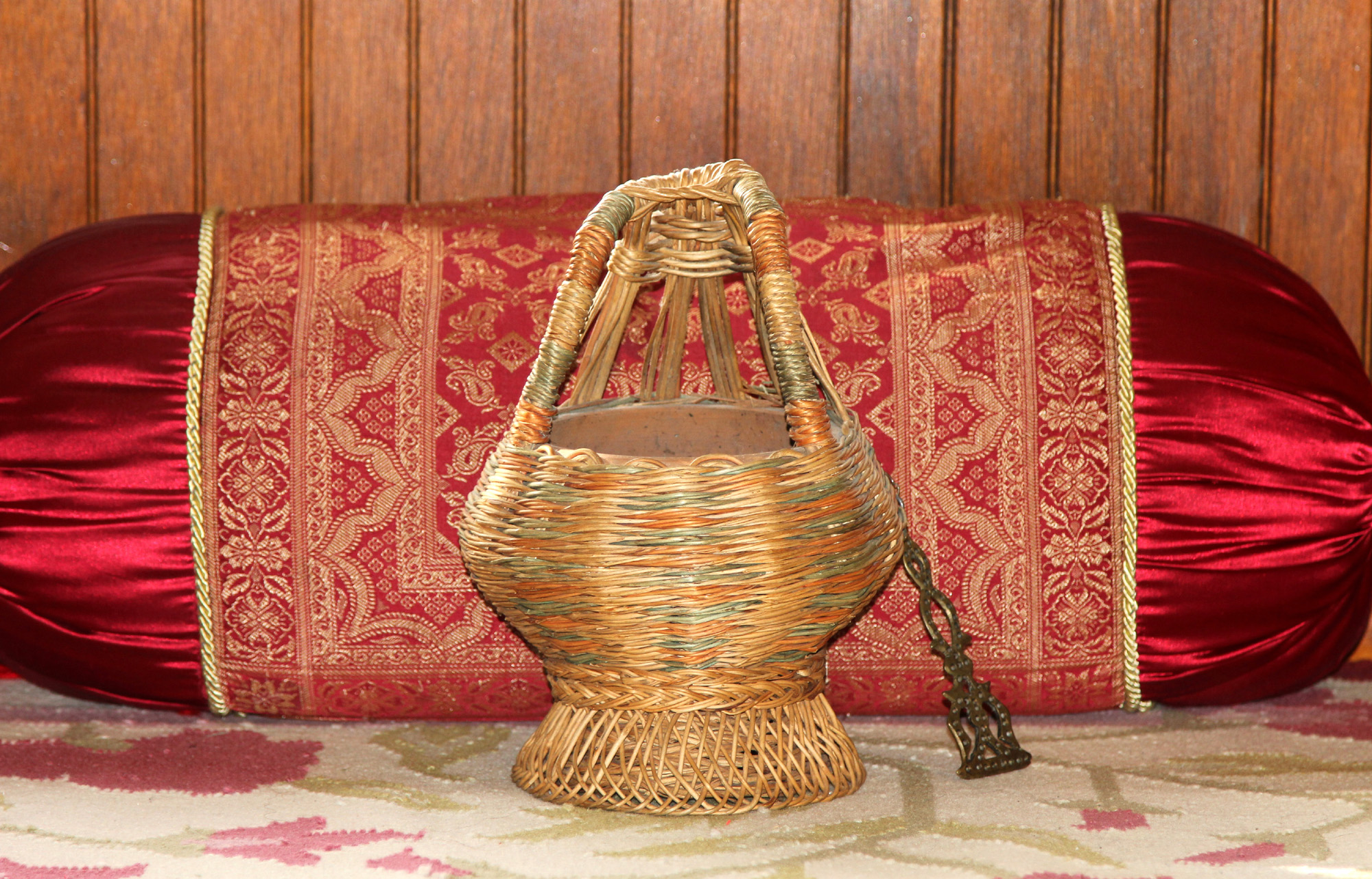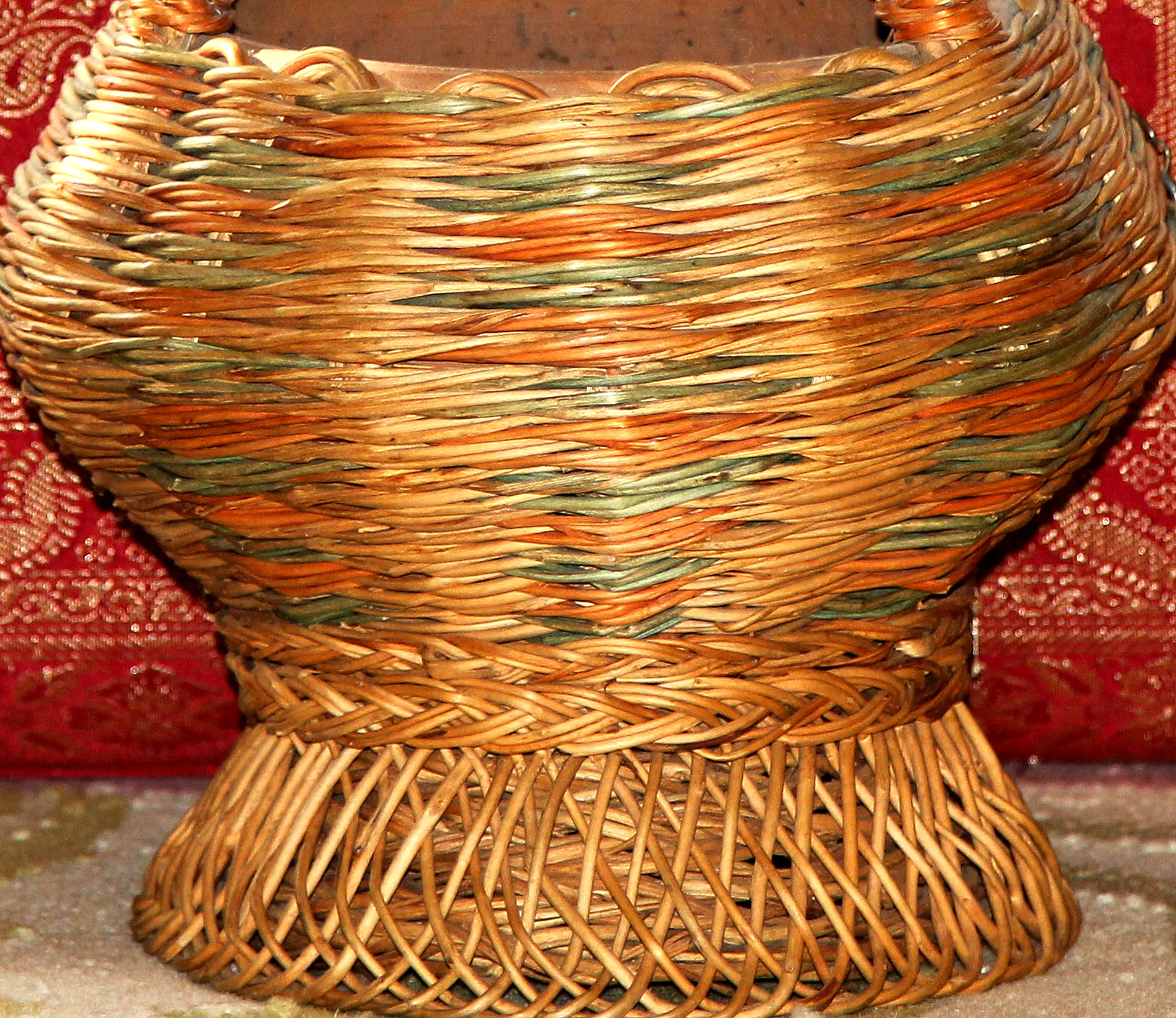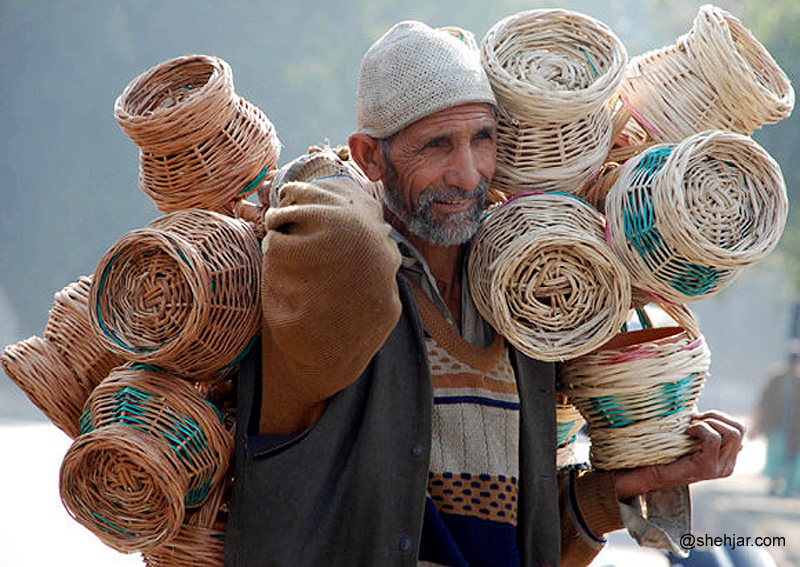 IMPORTANCE OF KANGIR IN KASHMIR-CULTURE Autar Krishan Razdan |
|
|
Kashmir
and Kangir are densely related to each other. Wherever the Kangir
reaches, it fuels the interest of people and from there an interest to
visit Kashmir. Kangirs are seen in every Kashmiri home, irrespective of
season. Kashmiris sometimes compare their own behavior with the behavior
of Charcoal used in the earthen bowl inside the Kangir. The way
charcoal burns hot with embers, then cools, and heats again upon
stirring is often compared with how Kashmiris burn hot and cold with
emotion. There is many Kashmiri proverbs about the Kangir.
Kashmiris are so attached to the Kangir that they find a reason to use it in every season. In colder months, it is carried inside of a long garment called the Pheran which is worn as an overall and kept close to the body. In lesser cold, it is used to warm the extremeties. It is sometimes used to bake a potato or to cook an egg. It is used to burn incense. The dangers of the Kangir to cause burn or fire nothwithstanding, it is held very dear by Kashmiris. They sing paeans for it: I am fond of you,my Kangir My Kangir,I have bought you from Chhaar My lovely Kangir of Anantnag I will die for you, my Kangir  In a Kashmiri folk-song, the yearly use of Kangir has been described by its fair weather friend in a beautiful manner: In a Kashmiri folk-song, the yearly use of Kangir has been described by its fair weather friend in a beautiful manner:Oh Kangir Charcoal will not burn in your bowl in April You will become untouchable in May You leave us in June Your youth goes in July Everybody forget you in August Yes,a messenger is sent to you in September to come again In October,Charcoal begins to burn in your bowl In November,you become my sweet- heart In December,I become your slave In January,dry leaves of Chinar are burnt in you In,February,I begin to distance from you In March,your importance is no more Not only Kashmiris, but all who visit Kashmir in the colder months love the Kangir. It is an important tool to save everyone in chilly weather. According to a Kashmiri proverb, the love for a Kangir matches the love of Lailafor Majnu. Without the Kangir, it would not be easy for Kashmiris to survive the cold. The same Kangir however becomes a weapon if God forbid someone has a slip of tongue. An exchange of bitter words could soon become an exchange of Kangirs, delivered directly to the other’s head. Wherever Kashmiris have gone, they have taken their Kangir along. Even in Rajasthan which is ruthlessly hot in the summer, it is used in a couple of cooler months or simply retained for decorative purposes. There is now production of the Kangir even in Jammu, the winter capital of state. However it is not much used in the very cold Ladakh. That might be due to the fact that the raw material which is used to make it is not available there. It may also be due to the non-availability of Charcoal, because there are no forests in this cold mountain desert. People In Ladakh mostly use indigenously produced woolens for protection from cold. The Kangir reached Amritsar and Lahore in the 19th century, alongwith Kashmiris who started to lodge there permanently. Certain Kangirs are being woven and prepared outside Kashmir also these days but the design and art of weaving a Kashmiri Kangir is confined to Kashmiris only. The Kangirs which are woven and prepared in Kashmir have their own form. Kangirs made in Bandipora and Chrar are considered most special of all Kangirs. The special type of weaving makes these Kangirs a work of art. That is why some people choose to keep these only for decorative purposes. A Kangir made of ‘Linya’ wicker work is considered the best and it remains warm for longer. Kangirs made in Zaingir are considered the most durable. One can put charcoal from the mulberry in these, even though it gets pretty hot. Durability of a Kangir depends on its size and the art of weaving. It depends upon the quality of wicker. It is necessary to have its upper part called the “Kop” built with wisdom. It must be stronger than all other parts. A Kangir woven in delicate branches of wicker, gives you more warmth, but this does not last long. These branches become dry fast and then burn dark. Kangirs woven with the “Posh” branches are thicker than others which makes them difficult to weave. Kangirs woven in delicate wicker branches with Bah branches in the uppermost part last longer. KEER and GEER branches are also used in weaving a Kangir. However in such cases, “cotton” is widely used. Here, “Cotton” means a composition of delicate and thick branches. The Kangirs woven using a composition of such branches are also called Astra Kangirs. To weave Kangirs, two main materials are used mostly.The terracotta firepot or a big cup called KANDUL and the branches of wicker.The main attraction of a Kangir made in Char town is that its terracotta firepot is like a cup woven in a special style.The skull of the Kangir called KUORIN comprises of three parts, CHOK, DAB and KOP. The lower side or seat of Kangir which is called CHOK, is usually made in a circular form but the Chok of these Kangirs is woven specially with glass tips. Kangirs made in other parts are also found in the same shape and size but a bit wider than the Kangirs made in the town of Char. For the weaving of delicate Kangirs, the middle of these is woven with coloured wicker branches. Apart from CHAM-CHAM Kangir, there are others that are woven delicately with a circular ring fabricated at the back. Its KOP or skull has two parts, DAR and PAHARI. The first rotates the face of Kangir in any direction and the second is of those delicate branches by which the circular ring is connected behind. Those Kangirs which have broken KOP or uppermost part have their Puhur upon seat. Those Kangirs which have strong KOP have their Puhur or branches on the firepot. Those Kangirs which have from fourteen to forty Puhurs are considered strong Kangirs. To flash the fire under the ash in the firepot of Kangirs, a flat plate of wood or silver which is called CHALLAN is used. The challan is tied with a thick string to the circular ring at the back of the Kangir. The branches of wicker are coloured before the Kangirs are woven and this is done by the Artisan himself.  Three items are used by an Artisan in weaving a Kangir and these are Anda or Neza, Aari and Cheelan, The first of these is used for cutting the wicker branches from the forest. After that, these branches are kept in water and cleaned with Cheelan. Ari is used in weaving. The raw material, which is Wicker branches is easily found from forests and Kandi areas. Posh branches are easily available in bushes which are found in number. Other types of branches are also found in many parts of Kashmir. Kundal or earthen parts are made by potters. There are some potters who make Kangir in the terracotta form which has the seat, body and upper parts all made of clay. These are called MANAN but are not commonly used because these cause burns easily. Who created the Kangir and where and how did it reach Kashmir? There are different opinions about this. Some scholars say that Italian tourists came to Kashmir along with Akbar the king and introduced the Kangir. Akbar presented it to Kashmiris in such a way that it became a part and parcel of their life. However this is not true. Any type of Italian firepot has nothing to do with the Kashmiri Kangir. Actually the firepot of Italians was in the shape of a pail with a handle on it and was called TURLA by the Romans.This has no resemblance with our Kangir. Even knowing this fact, some scholars say that Kangir has come from Italy. The fact is that our scholars of old have directly or symbolically mentioned about Kangir in their masterpieces. Kalhan has given this firepot the name “Kangadika.” Another scholar named Mankh has said in his masterpiece Shrikanthcharitra that as soon as winter starts in Kashmir, charcoal in ‘HASTINKA’ burns in such a way as the eyes of a raging man. And Kama had also played the same trick while controlling Shachi. Kalhan makes symbolic mention of Kangir in that efforts of man should be compared with burning charcoal, which burns anybody, anytime, into ashes. According to Sant Petasburg, Kalhana has used the word ‘Hastinka’ in the mention of King Vikramaditya in Rajtarangani. According to him he was the king of cruel nature, same as charcoals, which become fiery and cruel in a Kangir. In one of the Tarangas of Rajtarangni, he has also said something similar. What name Sanskrit scholars have given to Kangir, I have not much to say. However it is clear that Hastinka is not synonymous with Kangir nor is Kangir derived from Hastinka. While mentioning about Kangir, a famous intellectual of Kashmir said that the meaning of Kakshagni can be taken as fire of tree and derived from Kakshagni can be taken Kangir, which Kashmiris use as a firepot for warmth to the body. In Ragvamsha also, the meaning of Kangir is the same.The fire from wood or ALLAV is widely used for roadside warmth in parts of India. But how did the Kangir get its name? The thinking of scholars is:
 Kangir has played an important role in the religious as well as social life of kashmiris. It has become a symbol of the Kashmiris. In the marriage function of both Hindus and Muslims, a Kangir with burning charcoals is kept ready for burning ‘NAZAR’(some incense or such) for the bride or the groom. When the bride goes to her husband’s house, she is given a special Kangir for use in the first winter. This Kangir is called ‘MAHARNI-KANGAR and is specially built and woven using delicate wicker branches. Kangir also has special importance on the festival of Shivratri. Married Kashmiri Hindu women bring to their marital household a Kangir and a packet of salt given by their parents a few days before this festival.To get a Kangir on this occasion from parents is considered a must and a good omen. It is also practical and helpful because Shivratri is in the winter. On Makar Sankranti, which falls in the month of Jan-Feb, Pandits give Kangir to the needy as offering in the name of deceased. Muslims too give a Kangir to Masjid in the chilly-cold winter. On the eleventh day kriya of deceased Kashmiri Pandits offer Kangir to the priest. On the 8th day after Shivratri, there is much jubiliation on the banks of Vitasta with illumination of earthen lamps. This is followed by burning in flames of the old stock of Kangirs. This day is called TELA-ASHTAMI. From this day, temperatures in the valley start rising daily. Kangir is suitable to keep our body warm but if we use it on the naked body it can become the cause of a cancer called Kangir cancer. Whatever may be, and whatever new appliance comes in, Kashmiris continue to use the Kangir as their favorite basket of heat in winter. I believe that the Kangir remains popular because its use is deep in the culture of Kashmiri communities and has been for centuries. POSTED BY : VIPUL KOUL EDITED BY : ASHOK KOUL |
|
 Autar Krishan Razdan Autar Krishan RazdanSenior Fellow, Ministry of Culture, Govt of India |
|
Monday, December 14, 2015
IMPORTANCE OF KANGIR
Subscribe to:
Post Comments (Atom)

No comments:
Post a Comment